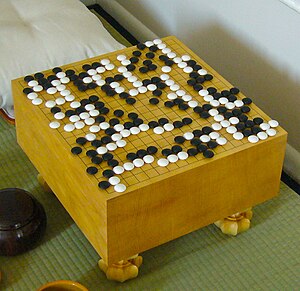Wéiqí
Go

Go is played on a grid of black lines (usually 19×19). Game pieces, called stones, are played on the lines' intersections.
|
| Years active |
prior to Zhou Dynasty (1046–256 BCE) to present |
| Genre(s) |
Board game
Abstract strategy game
|
| Players |
2 |
| Age range |
3+ |
| Setup time |
Minimal |
| Playing time |
Casual: 20–90 minutes
Tournament: 1–6 hours |
| Random chance |
None |
| Skill(s) required |
Strategy, tactics, observation
|
| Synonym(s) |
 Weiqi Weiqi
Igo / Paduk
Baduk
|
|
a Some professional games exceed 16 hours and are played in sessions spread over two days. |
| Transcriptions |
| Wylie |
mig mangs |
Go (traditional Chinese: 圍棋; simplified Chinese: 围棋; pinyin:  wéiqí; Japanese: 囲碁; rōmaji: igo; Korean: 바둑; romaja: baduk; literally: "encircling game") is an abstract strategy board game for two players, in which the aim is to surround more territory than the opponent.
wéiqí; Japanese: 囲碁; rōmaji: igo; Korean: 바둑; romaja: baduk; literally: "encircling game") is an abstract strategy board game for two players, in which the aim is to surround more territory than the opponent.
The game was invented in ancient China more than 2,500 years ago. It was considered one of the four essential arts of the cultured Chinese scholar caste in antiquity. The earliest written reference to the game is generally recognized as the historical annal Zuo Zhuan (c. 4th century BCE). The modern game of Go as we know it was formalized in Japan in the 15th century CE.
Despite its relatively simple rules, Go is very complex, even more so than chess, and possesses more possibilities than the total number of atoms in the visible universe. Compared to chess, Go has both a larger board with more scope for play and longer games, and, on average, many more alternatives to consider per move.
...
Wikipedia

![]() wéiqí; Japanese: 囲碁; rōmaji: igo; Korean: 바둑; romaja: baduk; literally: "encircling game") is an abstract strategy board game for two players, in which the aim is to surround more territory than the opponent.
wéiqí; Japanese: 囲碁; rōmaji: igo; Korean: 바둑; romaja: baduk; literally: "encircling game") is an abstract strategy board game for two players, in which the aim is to surround more territory than the opponent.